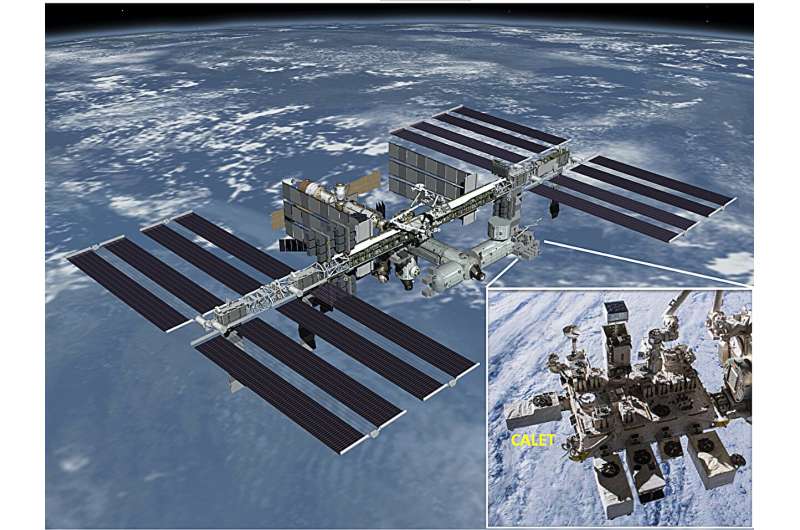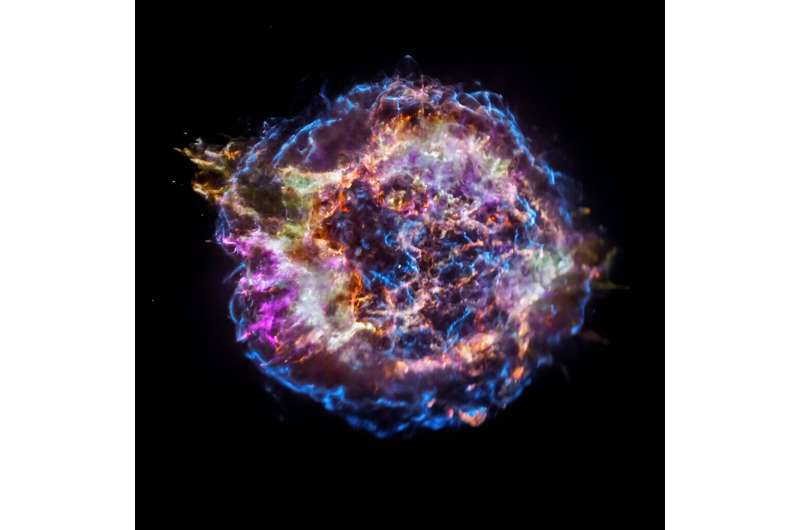This article has been reviewed according to Science X's editorial process and policies. Editors have highlighted the following attributes while ensuring the content's credibility:
fact-checked
peer-reviewed publication
trusted source
proofread
Study finds strongest evidence yet for local sources of cosmic ray electrons

A new study using data from the CALorimetric Electron Telescope (CALET) instrument on the International Space Station has found evidence for nearby, young sources of cosmic ray electrons, contributing to a greater understanding of how the galaxy functions as a whole.
The study is published in the journal Physical Review Letters.
The study included more than 7 million data points representing particles arriving at CALET's detector since 2015, and CALET's ability to detect electrons at the highest energies is unique. As a result, the data includes more electrons at high energies than any previous work. That makes the statistical analysis of the data more robust and lends support to the conclusion that there are one or more local sources of cosmic ray electrons.
"This is one of the primary things that CALET is made to look for," says Nicholas Cannady, an assistant research scientist with UMBC's Center for Space Sciences and Technology, a partnership with NASA Goddard Space Flight Center, and a leader on the study. With this paper, he adds, "We were really able to push into the realm where we have few events and start to look for things at the highest energies, which is exciting."
A better understanding of the galaxy
Current theory posits that the aftermath of supernovae (exploding stars), called supernova remnants, produce these high energy electrons, which are a specific type of cosmic ray. Electrons lose energy very quickly after leaving their source, so the rare electrons arriving at CALET with high energy are believed to originate in supernova remnants that are relatively nearby (on a cosmic scale), Cannady explains.
The study's results are "a strong indicator that the paradigm that we have for understanding these high-energy electrons—that they come from supernova remnants and that they are accelerated the way that we think they are—is correct," Cannady says. The findings "give insight into what's going on in these supernova remnants, and offer a way to understand the galaxy and these sources in the galaxy better."
CALET is a collaborative project built and operated by groups in Japan, Italy, and the United States, led by Shoji Torii. The lead contributors to this work in Japan are Torii, Yosui Akaike, and Holger Motz at Waseda University in Tokyo, and Louisiana State University is the lead institution in the U.S.

New data lead to new cosmic ray sources
Previous work found that the number of electrons arriving at CALET decreased steadily as energy increased up to about 1 teravolt (TeV), or 1 trillion electron volts. The number of electrons arriving with even greater energy was extremely low. But in this study, CALET did not see the expected dropoff. Instead, the results suggest that the number of particles plateau, and then even increase, at the highest energies—all the way up to 10 TeV in a few cases.
Previous experiments could only measure particles up to about 4 TeV, so the highest energy event candidates above that in this study are a crucial new source of information about potential nearby sources of cosmic ray electrons. Cannady led the effort to individually analyze each of those events to confirm they represent a real signal, and a deeper dive into those events is forthcoming.
Addressing challenges
It's difficult to distinguish between electrons and protons at high energies, and there are many more protons arriving than electrons, which poses challenges to an accurate analysis. To tell the particles apart, a program developed by the researchers analyzes how the particles break down when they hit the detector.
Protons and electrons break down differently, so comparing the cascade of particles they create in that process can filter out the protons. However, at the highest energies, the differences between protons and electrons decrease, making it harder to accurately remove only the protons from the data.
To address this, Cannady led the CALET team's effort to simulate the breakdown patterns of both protons and electrons coming from the exact direction each of the high-energy events arrived from. That increased the team's ability to determine whether the events are electrons or protons as accurately as possible.
Based on that work, "We believe we are evaluating the likelihood of events being protons in a realistic fashion," Cannady says. Enough presumed electrons remain in the dataset after that careful analysis to conclude there is a real signal.
Pushing boundaries
T. Gregory Guzik, professor of physics at LSU and the U.S. CALET collaboration lead, is excited that further analysis of the data suggested that electrons coming from the three best candidates for nearby supernova remnants can explain the high-energy arrivals.
"These CALET observations open the tantalizing possibility that matter from a particular nearby supernova remnant can be measured at Earth," Guzik shares. "Continued CALET measurement through the life of the International Space Station will help shed new light on the origin and transport of relativistic matter in our galaxy."
For Cannady, "The most exciting part is seeing things at the highest energies. We have some candidates above 10 TeV—and if it is borne out that these are real electron events, it's really a smoking gun for clear evidence of a nearby source," he says. "This is essentially what CALET was put up to do, so it's exciting to be working on this and to finally be getting results that are pushing the bounds of what we've seen before."
More information: O. Adriani et al, Direct Measurement of the Spectral Structure of Cosmic-Ray Electrons+Positrons in the TeV Region with CALET on the International Space Station, Physical Review Letters (2023). DOI: 10.1103/PhysRevLett.131.191001
Journal information: Physical Review Letters
Provided by University of Maryland Baltimore County




















